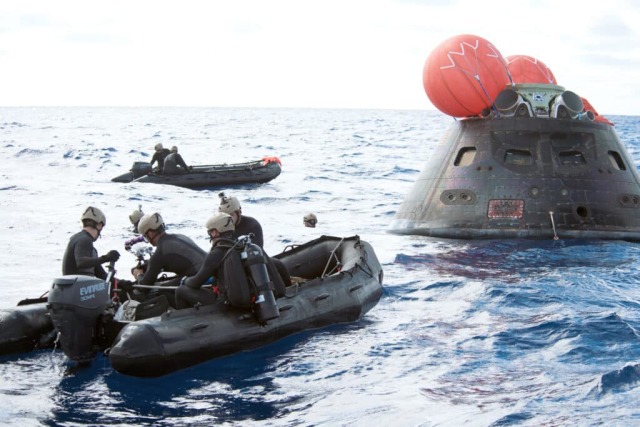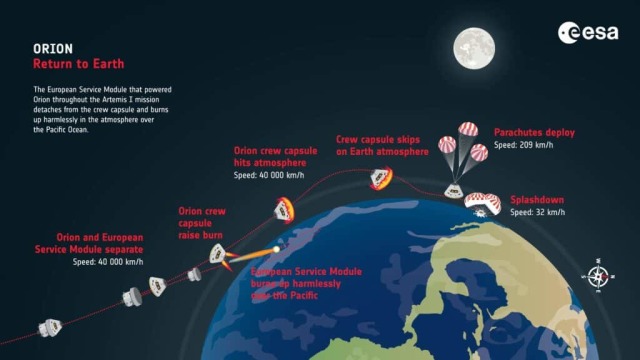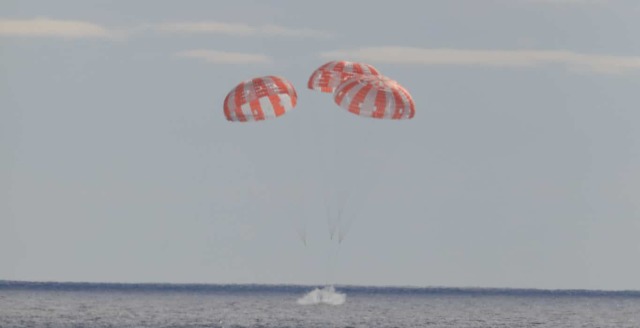Fifty years ago, on December 11, 1972, humanity set foot on the lunar surface for the last time — it was the Apollo 17 mission. By coincidence, it was on this date, but already half a century later, that the newest American spacecraft for traveling to the Moon returned from its first full-fledged flight.
According to the US National Aeronautics and Space Administration (NASA) in its official blog, the flooding occurred normally, on Sunday, December 11, at 9:40 Pacific time (PST, 20:40 Moscow time). Rescue teams met the Orion capsule in the Pacific Ocean east of Baja California.
In the coming hours, the ship will be prepared to be lifted onto the ship, then delivered to the shore, where it will be reloaded onto a trailer and transported to the Kennedy Space Center. Only there the capsule hatch can be opened and the condition of several physical as well as biological experiments can be checked. Then a long process of analyzing the data and the equipment on board Orion will begin — the technicians will have to make sure that all the systems of the manned spacecraft have worked out as they should.

US Navy personnel fish the Orion capsule out of the ocean after a test flight, 2014Image Source: U.S. Navy
It is worth noting that the Orion ship, which returned from the Artemis I mission, although this was its first trip to the Moon, managed to set several records at once. For example, he spent the most time in independent flight without connecting with other vehicles or stations of all manned spacecraft ever operated (albeit without people this time). And he also flew the longest distance in similar conditions — more than 2.24 million kilometers in 25.5 days of the Artemis I mission .
Another interesting detail of the flight is the orbit around the Moon, which Orion entered. During manned flights, when the lunar station is ready, the ship will dock to it. And both vehicles, as well as the Starsip Lunar or other lander, will be in an "almost rectilinear halo orbit" (near-rectilinear halo orbit, NRHO). But in the test flight, a different trajectory was chosen for Orion — a long-range retrograde orbit (DRO). Previously, only one man—made object occupied it near the moon - the Chinese probe Chang'e-5 after it sent a capsule with regolith samples to Earth.

Infographic with the main stages of the Orion spacecraft's return to EarthImage Source: ESA
Both of these orbits have been studied for a long time, but in practice their application began only in recent years. This is due to the great complexity of their calculation and the need to perform maneuvers with the highest accuracy. Previously, it was simply not possible to reduce the positioning error of the device in space to the required level. In relation to the exploration of the Moon, they are important for the following reasons:
- DRO is incredibly stable and allows long-term spacecraft to be placed in the lunar space (the Moon has a very heterogeneous gravitational field and this task is difficult to solve in other ways);
- NRHO is not so stable, but it allows you to maintain constant simultaneous radio contact with the Earth and the poles of the Moon.
Half a century ago, earthlings visited the satellite of their home planet for the last time and promised to return. The Apollo 17 mission was also notable for the first visit to the moon by professional geologist Harrison Schmitt. All previous crews consisted of astronaut pilots, who, although they underwent intensive training, did not have full-fledged field work experience. An even wider range of people will participate in flights under the Artemis program — including the first woman on the moon and the first non-white man. This is not only an important socio-political gesture, but also a clear demonstration that missions to other bodies of the Solar System are available to qualified specialists regardless of their physiology or race.

